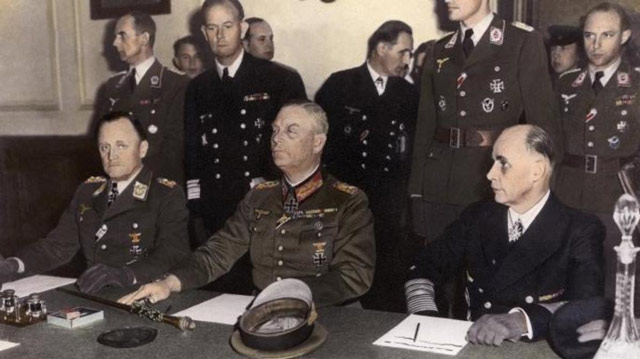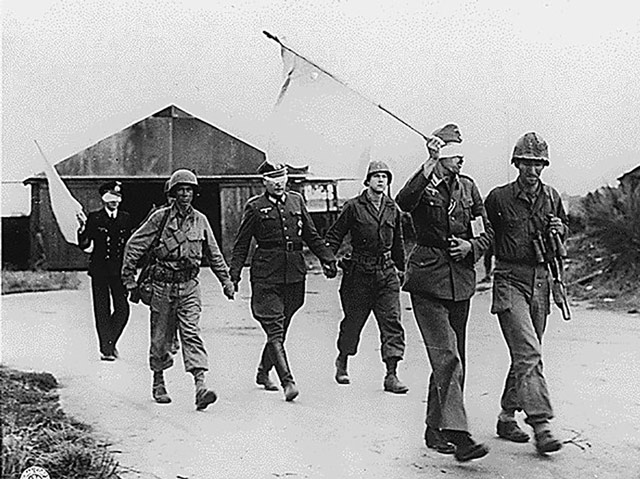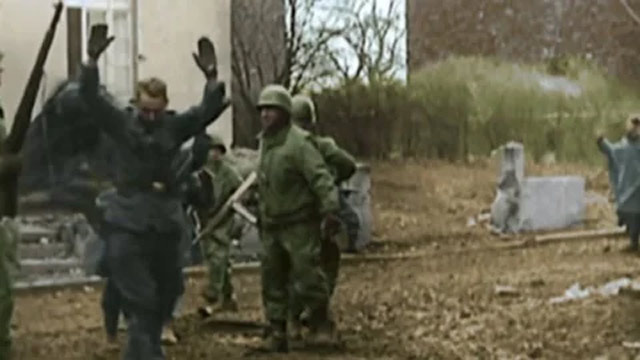Some Surprising Surrender Scenes
 |
| Field Marshal Keitel surrenders. |
This page looks at German surrenders in World War II.
The final act of any war is delicate. The defeated are looking for ways to surrender, while the victors are still busy prosecuting their successful campaign.
I decided to collect together scenes of German soldiers surrendering in 1944 and 1945 because it's important to understand what defeat looks like.
 |
| German officers surrender in Brest, France, 1944. |
While the ideology of the Third Reich made surrender seem unthinkable, it because quite easy to do. There was an art to it. The most important factor was determining who you were going to surrender to. Wehrmacht soldiers went to great lengths to avoid surrendering to the Red Army.
Field Marshal Ferdinand Schörner even went so far as to fly out of his pocket in the East so that he could find some Americans to accept his surrender. His men, of course, weren't so lucky.
Of course, there were plenty of younger men, too. But not nearly as many as there had been five years earlier.
A lot of the soldiers surrendering were wounded. They didn't always receive medical care. That was another reason to choose the people who were going to accept your surrender carefully.
Isolated battles continued throughout May 1945 long after the Reich officially surrendered. German soldiers particularly resisted strongly when faced with surrender to the Red Army.
Some isolated outposts were unable to surrender because there was nobody to surrender to. A small German meteorological party on Bear Island in the Arctic finally surrendered to some Finnish seal hunters on 4 September 1945. This was after even the Japanese had surrendered.
German U-boats usually surrendered as quickly as they could find some way to surrender. A couple of U-boats, however, continued on after news of the end of the war and did not surrender until July and August 1945. U-977 held out until finally giving in at Mar Del Plata, Argentina, on 17 August 1945. There were rumors that one U-boat even torpedoed a Brazilian ship after the surrender, but that's considered just a legend.
Fighting continued on the Dutch island of Texel until 20 May 1945 between Georgian conscripts and German soldiers. Hundreds of men on both sides perished after the conscripts revolted. When they returned to the Soviet Union, the Georgian rebels were treated as criminals and traitors by the Stalin regime for having worked for the Germans.
One Japanese soldier, Hiroo Onoda, survived in the hills of the Philippines. He refused to surrender even when told repeatedly that the war was over. Finally, he surrendered in 1974 after his former commanding officer gave him a specific order to do so.
Now, of course, it's all just a distant memory. But it's always good to know what happens when you lose a hard war.
2021
When looking at these clips, it may strike you that these don't always look like soldiers and think we've mixed in some footage of ordinary refugees. You're 100% correct that they don't look like soldiers, but they were. There were boys, old men, women, old women. Such people were all pressed into service in the final days of the Third Reich because so many young men imbued with the Third Reich ideology had died because of it.
Nearly 3 million Wehrmacht troops surrendered to the Western Allies from D-Day, 6 June 1944, until V-E Day, 8 May 1945. Quite a few, probably around the same number, surrendered to the Red Army, but figures from there are harder to come by. About 800,000 soldiers surrendered to the Soviets just in 1945.
Isolated battles continued throughout May 1945 long after the Reich officially surrendered. German soldiers particularly resisted strongly when faced with surrender to the Red Army.
There was a Japanese delegation in Berlin. Every man committed suicide rather than surrender, which was customary for Japanese troops in World War II.
Some isolated outposts were unable to surrender because there was nobody to surrender to. A small German meteorological party on Bear Island in the Arctic finally surrendered to some Finnish seal hunters on 4 September 1945. This was after even the Japanese had surrendered.
German U-boats usually surrendered as quickly as they could find some way to surrender. A couple of U-boats, however, continued on after news of the end of the war and did not surrender until July and August 1945. U-977 held out until finally giving in at Mar Del Plata, Argentina, on 17 August 1945. There were rumors that one U-boat even torpedoed a Brazilian ship after the surrender, but that's considered just a legend.
Fighting continued on the Dutch island of Texel until 20 May 1945 between Georgian conscripts and German soldiers. Hundreds of men on both sides perished after the conscripts revolted. When they returned to the Soviet Union, the Georgian rebels were treated as criminals and traitors by the Stalin regime for having worked for the Germans.
 |
| German soldiers surrender at Marburg. |
No comments:
Post a Comment